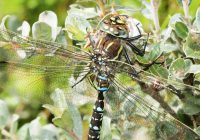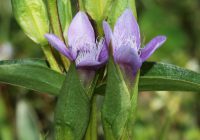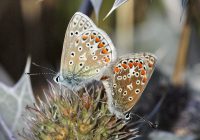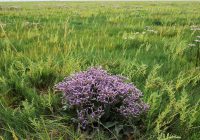Dr Phil Smith’s Wildlife Notes
August 2015
August was a rather cool and unsettled month, though rainfall amounts were no more than average, contrasting with record deluges in the south. The rain that did fall soon evaporated making little impact on the depleted water-table.
The 50th anniversary bash for Ainsdale Sand Dunes National Nature Reserve on 8th fortunately coincided with a sunny day. Large numbers of local people enjoyed a range of events from Landrover safaris to sheep herding. It was good to see plenty of children there, a Sand Lizard and Natterjack Toad being especially popular exhibits. My wildflower guided walk attracted a group of eight, the route via Pinfold Pond enabling me to show them a new plant for the reserve discovered a few days before. This is the rather distinctive, if esoteric, hybrid between the Creeping and Marsh Thistle which rejoices in the name Cirsium ×celakovskianum. We were also distracted by three large and brightly coloured dragonflies: the Emperor, Brown Hawker and Southern Hawker, cruising around the pond.
Several visits during the month to our prime dragonfly locality, slack 47 – a group of four scrapes in the Birkdale frontal dunes – were rewarded by the discovery of an immaculate male Common Hawker which spent over a week patrolling magnificently and frequently clashing with the resident Emperor. The latter, usually the dominant species, became somewhat worse for wear with large chunks missing from his wings. Breeding on more acidic waters well inland, Common Hawkers are rare on the coast; I have seen only a handful in over 40 years. This one even perched briefly for photographs and was the star performer for a well-attended dragonfly guided walk organised by the Sefton Coast Landscape Partnership Scheme (LPS) on 16th. We also found a newly emerged Migrant Hawker, while I was able to net both Common and Ruddy Darter to compare identification features in the hand. The slack 47 scrapes were restored by LPS in 2012 and this year no fewer than 16 species of dragonfly have been recorded there, an extraordinary total for a single Northwest site.
The following day, I was delighted to find dozens of glorious Field Gentians in full flower in the big slacks south of Ainsdale Discovery Centre. The Sefton duneland is one of the British hotspots for this nationally declining plant. Walking back through the frontal dunes, I enjoyed several Graylings and Common Blues nectaring on Sea Holly flowers.
Another guided walk took in the Devil’s Hole, an enormous blow-out in the Ravenmeols Local Nature Reserve. The timing was just right to see a spectacular flowering of one of our most iconic wild flowers, the Grass-of-Parnassus, a mainly northern species described as “Vulnerable” in the Red List for England but still doing well on the Sefton Coast. Less expected was a juvenile Cuckoo spotted by John Dempsey.
Following up a report of possible Common Club-rush on Freshfield Dune Heath Nature Reserve, I joined Catherine Highfield to search one of the ponds excavated several years ago and now much overgrown. The plant turned out to be the closely related Grey Club-rush, rather than the much rarer target species. However, our time wasn’t wasted, as we spotted Water Figwort, new to the reserve and had good, if brief, views of a Water Vole on the edge of another pond, only the second I have seen here.
Sea-lavenders were first recorded on the south Ribble saltmarshes at Marshside in 2008. Since then, Patricia Lockwood and I have re-surveyed them at intervals, discovering this month a big increase in the number of both Common and Lax-flowered Sea-lavenders and their rare hybrid. The reddish-purple of these lovely plants stands out amongst the lilac masses of Sea Aster, making it possible to spot them from a distance using binoculars.
Another ongoing survey is into vegetation colonising Birkdale Green Beach, one of my favourite places. It is usually quiet, though not necessarily safe, as demonstrated on 20th when I was charged by a pack of six out-of-control dogs. Luckily I escaped without being bitten. Regrettably, this kind of unpleasant experience seems all too common these days.




